

Photon Mapping - Словарь терминов. [1] Каустика – оптический эффект, выражающийся в концентрации на небольшой площади преломлённых при переходе из одной среды в другую (например, из воздуха в воду) световых лучей.
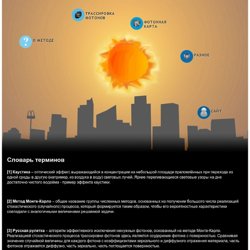
Яркие переливающиеся световые узоры на дне достаточно чистого водоёма - пример эффекта каустики. Www.enggjournals.com/ijcse/doc/IJCSE12-04-02-032.pdf.
Photon mapping. Unlike path tracing, bidirectional path tracing and Metropolis light transport, photon mapping is a "biased" rendering algorithm, which means that averaging many renders using this method does not converge to a correct solution to the rendering equation.

However, since it is a consistent method, a correct solution can be achieved by increasing the number of photons. Effects[edit] Caustics[edit] Diffuse interreflection[edit] Subsurface scattering[edit] Subsurface scattering is the effect evident when light enters a material and is scattered before being absorbed or reflected in a different direction. Usage[edit] Construction of the photon map (1st pass)[edit] With photon mapping, light packets called photons are sent out into the scene from the light sources. Once the photon map is constructed (or during construction), it is typically arranged in a manner that is optimal for the k-nearest neighbor algorithm, as photon look-up time depends on the spatial distribution of the photons.
Алиасинг (обработка сигналов) Ray tracing (graphics) The ray tracing algorithm builds an image by extending rays into a scene Optical ray tracing describes a method for producing visual images constructed in 3D computer graphics environments, with more photorealism than either ray casting or scanline rendering techniques.
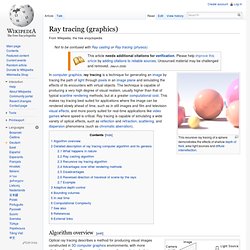
It works by tracing a path from an imaginary eye through each pixel in a virtual screen, and calculating the color of the object visible through it. Scenes in ray tracing are described mathematically by a programmer or by a visual artist (typically using intermediary tools). Scenes may also incorporate data from images and models captured by means such as digital photography. Typically, each ray must be tested for intersection with some subset of all the objects in the scene. It may at first seem counterintuitive or "backwards" to send rays away from the camera, rather than into it (as actual light does in reality), but doing so is many orders of magnitude more efficient.
Ray Tracing. Ray tracing produces information regarding the precise rays between a transmitter and a receiver and is thus suitable in point-to-point scenarios where there are only a few receiver locations of interest.
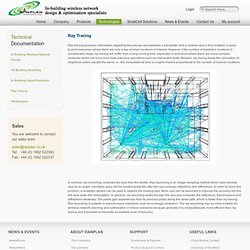
However, if the number of prediction locations is considerably large, ray tracing will suffer from a long running time, especially in scenarios where there are many complex obstacles which will incur more data-intensive operations such as intersection tests. Besides, ray tracing treats the calculation of neighbour pixels equally the same i.e., the computational time is roughly linearly proportional to the number of receiver locations. In contrast, ray launching computes the rays from the emitter. Ray launching is an image-sampling method which uses discrete rays by an angle. Inevitably, gaps will be created gradually after the rays undergo reflections and diffractions.
Tethering. A phone tethered to a laptop.
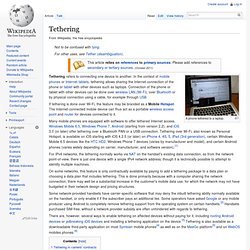
Tethering refers to connecting one device to another. In the context of mobile phones or Internet tablets, tethering allows sharing the Internet connection of the phone or tablet with other devices such as laptops. Connection of the phone or tablet with other devices can be done over wireless LAN (Wi-Fi), over Bluetooth or by physical connection using a cable, for example through USB. For IPv4 networks, the tethering normally works via NAT on the handset's existing data connection, so from the network point-of-view, there is just one device with a single IPv4 network address, though it is technically possible to attempt to identify multiple machines. Internet Technology/Physical Radio Propagation Models (Nico)/Aroma-eleryan.pdf. Assessing the Impact of a Realistic Radio Propagation Model on VANET Scenarios Using Real Maps.
Radio propagation. Radio propagation is affected by the daily changes of water vapor in the troposphere and ionization in the upper atmosphere, due to the Sun.
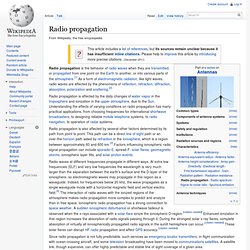
Understanding the effects of varying conditions on radio propagation has many practical applications, from choosing frequencies for international shortwave broadcasters, to designing reliable mobile telephone systems, to radio navigation, to operation of radar systems. Radio propagation is also affected by several other factors determined by its path from point to point. This path can be a direct line of sight path or an over-the-horizon path aided by refraction in the ionosphere, which is a region between approximately 60 and 600 km.[3] Factors influencing ionospheric radio signal propagation can include sporadic-E, spread-F, solar flares, geomagnetic storms, ionospheric layer tilts, and solar proton events. Radio waves at different frequencies propagate in different ways. Experimental Evaluation of Wireless Simulation Assumptions. Radio propagation model. Characteristics[edit] As the path loss encountered along any radio link serves as the dominant factor for characterization of propagation for the link, radio propagation models typically focus on realization of the path loss with the auxiliary task of predicting the area of coverage for a transmitter or modeling the distribution of signals over different regions.
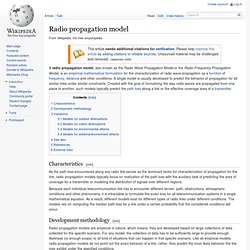
Because each individual telecommunication link has to encounter different terrain, path, obstructions, atmospheric conditions and other phenomena, it is intractable to formulate the exact loss for all telecommunication systems in a single mathematical equation. MIMO. Understanding of SISO, SIMO, MISO and MIMO In radio, multiple-input and multiple-output, or MIMO (pronounced my-moh by some and me-moh by others), is the use of multiple antennas at both the transmitter and receiver to improve communication performance.
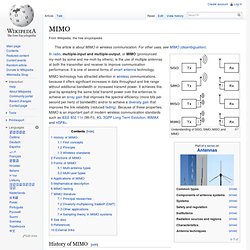
It is one of several forms of smart antenna technology. MIMO technology has attracted attention in wireless communications, because it offers significant increases in data throughput and link range without additional bandwidth or increased transmit power. It achieves this goal by spreading the same total transmit power over the antennas to achieve an array gain that improves the spectral efficiency (more bits per second per hertz of bandwidth) and/or to achieve a diversity gain that improves the link reliability (reduced fading). Тонкости применения MIMO в беспроводных технологиях. MIMO. MIMO (англ.
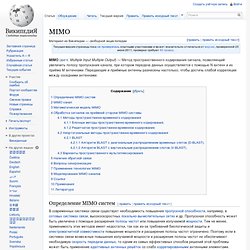
Multiple Input Multiple Output) — Метод пространственного кодирования сигнала, позволяющий увеличить полосу пропускания канала, при котором передача данных осуществляется с помощью N антенн и их приёма М антеннами. Передающие и приёмные антенны разнесены настолько, чтобы достичь слабой корреляции между соседними антеннами. Определение MIMO систем[править | править исходный текст] В современных системах связи существует необходимость повышения пропускной способности, например, в сотовых системах связи, высокоскоростных локально-вычислительных сетях и др. Пропускная способность может быть увеличена с помощью расширения полосы частот или повышения излучаемой мощности. Survey of channel and radio propagation models for wireless MIMO systems.